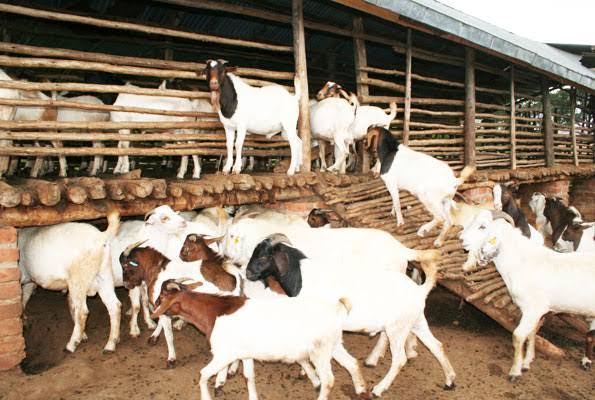15 Symptoms that your Goat is Dying and What to Do to Arrest it
 Learn More
Learn More1. Lethargy:
Causes: Lethargy in goats can be attributed to various factors, such as infections (like pneumonia or enterotoxemia), mineral deficiencies, or metabolic issues.
Diagnosis & Treatment: Isolate the goat, check its temperature, observe breathing patterns, and look for other symptoms. A vet can perform blood tests and prescribe appropriate antibiotics or supplements.
2. Loss of Appetite:
Causes: Loss of appetite can stem from dental problems, sudden feed changes, infections (e.g., listeriosis), or stress.
Diagnosis & Treatment: Inspect the goat’s mouth, ensure a consistent diet, and watch for other signs like fever or disorientation. Vet assistance might involve antibiotics or supportive care.

3. Weight Loss:
Causes: Weight loss can be due to internal parasites , poor nutrition chronic infections or underlying diseases like Johne’s disease.
Diagnosis & Treatment: Perform fecal exams for parasites, review feeding practices, and consider blood tests. Deworming, adjusting diet, and isolating sick goats are common strategies.
4. Coughing or Sneezing:
Causes: Respiratory issues arise from viral or bacterial infections (e.g.. Mycoplasma pneumonia), dusty or damp living conditions. or exposure to extreme weather.
READ ALSO How to Manage the Health of Animals to the Best from them
Diagnosis & Treatment: Isolate affected goats, observe nasal discharge, cough frequency, and breathing rate. Consult a vet for antibiotics, supportive care, and improved ventilation.
5. Nasal Discharge:
Causes: Nasal discharge can signal respiratory infections (e.g., contagious caprine pleuropneumonia), allergies, or irritants.
Diagnosis & Treatment: Examine discharge
color, consistency, and accompanying symptoms. A vet can prescribe antibiotics, anti-inflammatories, and offer guidance on improving living conditions.
6. Watery Eyes:
Causes: Excessive tearing might result from dust, infections like pink eye (conjunctivitis), or foreign objects.
Diagnosis & Treatment: Inspect eyes for signs of irritation or cloudiness. Rinse eyes with saline solution, apply prescribed ointments, and ensure clean bedding.
7. Fever:
Causes: Fever can be due to infections (e.g.. goat pox), inflammation, or metabolic issues.
Diagnosis & Treatment: Use a rectal thermometer to check body temperature. A vet’s evaluation is vital for determining the underlying cause and prescribing appropriate treatment.
8. Diarrhea:
Causes: Diarrhea stems from dietary
changes, bacterial infections (e.g., coccidiosis), or viral diseases like rotavirus.
Diagnosis & Treatment: Assess stool consistency, color, and frequency. Conduct fecal tests, isolate affected goats, administer electrolytes, and follow vet recommendations.
READ ALSO How Prevent deadly diarrhoea in your calves
9. Constipation:
Causes: Constipation might arise from dehydration, inadequate fiber intake, or underlying health issues.
Diagnosis & Treatment: Check rectal temperature and assess feces for consistency. Offer plenty of fresh water, high- fiber feed, and consult a vet if symptoms persist.
Read Also: 10 Home Remedies for Sick Goats [Beginner’s Guide]
10. Droopy Ears:
Causes: Drooping ears can result from fever,
stress, or pain associated with various illnesses.
Diagnosis & Treatment: Evaluate body temperature, check for signs of distress or injury. Address underlying issues, provide pain relief if necessary, and ensure proper care.
ATTENTION: Click “HERE” to our WhatsApp group and receive More updates directly on your WhatsApp!
11. Separation from the Herd
Causes: Isolation might indicate bullying. illness, or stress.
general health. Address herd dynamics, provide proper shelter, and monitor the isolated goat closely.
12. Change in Behavior:
Causes: Drastic behavioral changes might signal pain, discomfort, or neurological issues.
Diagnosis & Treatment: Note any unusual behavior patterns, assess for injuries, and consult a vet for thorough evaluation and appropriate treatment.
13. Hoof Problems:
Causes: Hoof issues can arise from infections (e.g., foot rot), improper trimming, or nutritional imbalances.
Diagnosis & Treatment: Examine hooves for swelling, odor, or discharge. Isolate affected goats, trim hooves properly, and provide antibiotics or other treatments as recommended by a vet.
14. Rough Coat:
Causes: A dull, unkempt coat might be due to poor nutrition, external parasites (lice, mites), or underlying health issues.
Diagnosis & Treatment: Inspect the coat for signs of parasites or skin conditions. Enhance nutrition, treat for parasites, and consider consulting a vet for a health assessment.
15. Labored Breathing:
Causes: Labored breathing can be linked to lung infections (e.g.. pneumonia), heart issues, or respiratory distress.
Diagnosis & Treatment: Observe breathing patterns, respiratory rate, and listen for wheezing. Immediate veterinary attention is crucial for diagnosing the underlying cause and instituting appropriate treatment.
As a seasoned farmer, I encourage continuous learning and close collaboration with veterinarians. Early intervention and thorough understanding of these symptoms can significantly improve goat health and ensure a thriving herd.















